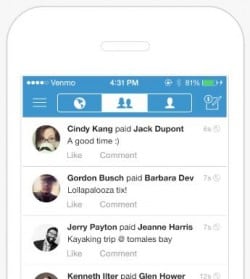
I know I’ve written a lot about China and the Chinese internet giants for the past couple of years, whilst leaving out much of what’s happening in the USA. It’s not to say the USA is boring, but it’s not innovating at the speed, rate or scale of the Chinese internet companies. By way of example, Alibaba and Tencent EACH process more payments transactions per month than PayPal processes in a year!
Nevertheless, it’s not to say there are no interesting things happening in America. For several years, I’ve talked about the story of Venmo, and the fact that it’s grown into the largest mobile payments wallet in the USA through being viral and social. It all began in 2010 when Iqram stayed with Andrew and forgot his wallet. As Venmo co-founder Andrew Kortina writes about it:
One of the weekends we were getting together to work on this idea, Iqram was visiting me in NYC and left his wallet in Philly. I covered him for the whole weekend, and he ended up writing me a check to pay me back. It was annoying for him to have to find a checkbook to do this, and annoying for me to have to go to the bank if I wanted to cash it (I never did). We thought, “Why are we still doing this? We do everything else with our phones. We should definitely be using PayPal to pay each other back. But we don’t, and none of our friends do.” So we decided, let’s just try to solve this problem, and build a way to pay each other back that feels consistent with all of the other experiences we have in apps we use with our friends.
Now Andrew and Iqram were 26 when they founded Venmo as a payment system*, and are part of my story about how teenagers and millennials are writing the future of payments because they can code.
Venmo was acquired by Braintree in 2012 for $26 million and Braintree was acquired by PayPal in 2013 for $800 million. PayPal saw the opportunity for Venmo and turbo-charged it such that it has become America’s favourite mobile social app, processing $35 billion in 2017 and now a verb: I just venmo’d you.
And it’s still growing fast. In Q1 of 2018, Venmo processed $12.3 billion in payment volume, up 80% compared to the same quarter last year, and acquired more active users than any previous quarter. This figure increased to $14 billion in Q2. Equally, Venmo is being used largely for peer-to-peer payments, but PayPal has ambitious plans to expand Venmo to merchant services over the next few years.
In fact, the PayPal influence is quite interesting, as Andrew and Iqram had to grow up fast under their stewardship. For example, as an example of that youthful exuberance that illustrates well the friction between Fin and Tech, a story in Fast Company talks about Andrew and Iqram being out on the lash. Seeing a hilariously awful T-Shirt in a shop, they bet one of their staffers $50,000 that he wouldn’t wear it. Duly challenged, the T-Shirt was acquired and worn, and in the wee hours of the morning a $50,000 Venmo transaction was made … three months later Iqram Magdon-Ismail, the then-president of Venmo, was sitting in front of PayPal’s compliance team, trying to explain why he was exchanging tens of thousands of dollars with employees. Oh dear …
It is not without competition however, as America's big banks saw Venmo’s success and launched Zelle in 2017. Zelle is already processing more than Venmo - $28 billion in Q2 2018 compared to Venmo’s $14 billion - but my American colleagues compare Zelle to Venmo as a bit like LinkedIn to Snapchat. One is cool for professionals whilst the other is cool for millennials.
A great example of this a Bloomberg report that Venmo is the place where parents stalk their kids. This is because each social payment can be accompanied with a few words to describe what the payment is for:
Nowhere is the gulf between young and older more obvious, and more readable, than on Venmo, the person-to-person money-transferring app owned by PayPal Holdings Inc … John Metcalf, 54, found it difficult to construct a narrative around “dick order.” That was what a friend of his daughter Jeana wrote on Venmo to explain a payment Jeana made. The Venmo post was “totally random,” Jeana Metcalf, 20, said in an interview. Her friend was just being funny, she said. But when her father asked her about it, she freaked.
All in all, I really like Venmo … but the combined processing of Venmo and Zelle and other American P2P payment systems is dwarfed when you think it totalled around $150 billion in 2017, compared to China’s $15 trillion. No wonder I write so much about China.
* Venmo actually launched in 2009 as a music start-up that allowed people to send a text to a band, which would then return an MP3 of one of the band’s hits in their email. The name comes from vendere, Latin for "to sell," and "mo" for mobile.
Chris M Skinner
Chris Skinner is best known as an independent commentator on the financial markets through his blog, TheFinanser.com, as author of the bestselling book Digital Bank, and Chair of the European networking forum the Financial Services Club. He has been voted one of the most influential people in banking by The Financial Brand (as well as one of the best blogs), a FinTech Titan (Next Bank), one of the Fintech Leaders you need to follow (City AM, Deluxe and Jax Finance), as well as one of the Top 40 most influential people in financial technology by the Wall Street Journal's Financial News. To learn more click here...


